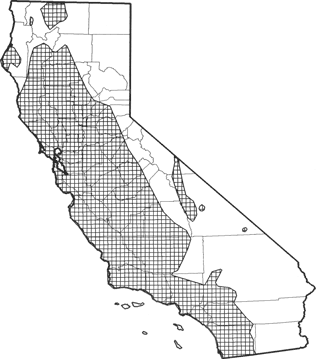
California Vole
Distribution, Abundance, and Seasonality
Occurs from the Sierra Nevada and Cascades west to the Pacific Coast, and from Trinity, Mendocino, and Shasta cos. south to San Diego Co. It is absent from northern Humboldt and Del Norte cos., and from the southern deserts. Occurs in the Owens Valley, and in disjunct populations in Inyo, Siskiyou, and Humboldt cos. Occurs in a wide variety of habitats, but most abundant in early seral stages of montane riparian, dense annual grassland, and wet meadow. The Amargosa vole, (M. c. scirpensis) is known only from 7 bulrush marshes along the Amargosa River in southeastern Inyo Co., and is Endangered (California Dept. Fish and Game 1980a).

Range Map
Specific Habitat Requirements
Feeding: Feeds mainly on leafy parts of grasses, sedges, and herbs. Forages on ground, clipping grasses and forbs at the bases, forming a network of runways leading from the burrow (Gill 1977).
Cover: Seeks cover in dense grass, beneath plant residues, in brush piles, beneath logs, and in underground burrows. Burrows are constructed in soft soil.
Reproduction: A nest of dried grass is built in a shallow underground burrow.
Water: Drinks water in captivity, but under natural conditions water can be obtained from succulent vegetation.
Pattern: Meadows and grasslands with friable soil.
Species Life History
Activity Patterns: Yearlong circadian activity.
Seasonal Movements / Migration: None.
Home Range: Mean home range size in Monterey Co. was 0.15 ha (0.37 ac), varying from 0.1 to 1.0 ha (0.25 to 2.5 ac) (Fisler 1962). In Contra Costa Co., most activity was within a 5 m (16 ft) radius, varying up to 15 m (49 ft), or more (Pearson 1960). Brant (1962) found movements of up to 34 m (110 ft) between recaptures.
Territory: Territorial behavior weak; size of area defended unknown.
Reproduction: Breeds throughout the year, reaching peaks whenever food and cover are abundant. Gestation 21 days. Litter size averages 4 (range 1-9). Two to 5 litters each yr. Weaning occurs at around 21 days. Females reach sexual maturity at 29 days on average, but as early as 21 days (Greenwald 1957, Hoffmann 1958, Brant 1962, Batzli and Pitelka 1971).
Niche: The California vole is a widespread and common herbivore in California. Its abundance and widespread distribution, along with daylong activity, make it an important prey. Predators include nocturnal and diurnal birds of prey, predatory mammals, and snakes.
Sources & References
California Department of Fish and Game, 1999.
California's Wildlife, Sacramento, CA.
Written by: P. Brylski, reviewed by: H. Shellhammer, edited by: R. Duke
Batzli, G. O. 1968. Dispersion patterns of mice in California annual grassland. J. Mammal. 49:239-250. Batzli, G. O., and F. A. Pitelka. 1971. Conditions and diet of cycling populations of the California vole, Microtus californicus. J. Mammal. 52:141-163. Brant, D. H. 1962. Measures of the movements and population densities of small rodents. Univ. Calif. Publ. Zool. 62:105-184. California Department of Fish and Game. 1980a. At the crossroads: a report on the status of California's endangered and rare fish and wildlife. Sacramento. 149pp. Fisler, G. F. 1962. Homing in the California vole, Microtus californicus. Am. Nat. 68:357- 368. Gill, A. E. 1977. Food preferences of the California vole, Microtus californicus. J. Mammal. 58:229-233. Greenwald, G. S. 1957. Reproduction in a coastal California population of the field mouse, Microtus californicus. Univ. Calif. Publ. Zool. 54:421-446. Hoffmann, R. S. 1958. The role of reproduction and mortality in population fluctuations of voles. (Microtus). Ecol. Monogr. 25:79-109. Krebs, C. J. 1966. Demographic changes in fluctuating populations of Microtus californicus. Ecol. Monogr. 36:239-273. Pearson, O. P. 1960. Habits of harvest mice revealed by automatic photographic recorders. J. Mammal. 41:58-74.
California Animal Facts | California's Wildlife